Flower Power
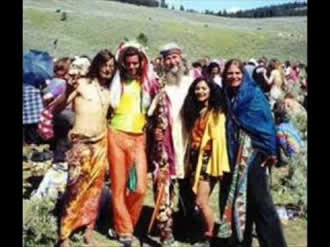
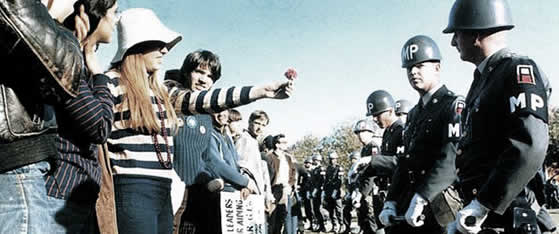
Flower Power originated in Berkeley, California, as a symbolic action of protest against the Vietnam War. In his November 1965 essay titled How to Make a March/Spectacle, Ginsberg advocated that protesters should be provided with “masses of flowers” to hand out to policemen, press, politicians and spectators.
The use of props like flowers, toys, flags, candy and music were meant to turn anti-war rallies into a form of street theater thereby reducing the fear, anger and threat that is inherent within protests. In particular, Ginsberg wanted to counter the “specter” of the Hells Angels motorcycle gang who supported the war, equated war protesters with communists and had threatened to violently disrupt planned anti-war demonstrations at the University of California, Berkeley.
Using Ginsberg’s methods, the protest received positive attention and the use of “flower power” became an integral symbol in the counterculture movement.
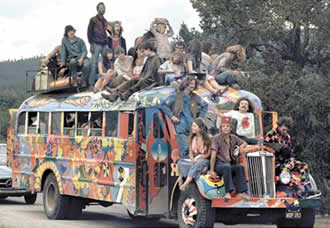 By late 1966, the Flower Power method of guerrilla theater had spread from California to other parts of the United States.
By late 1966, the Flower Power method of guerrilla theater had spread from California to other parts of the United States.
The Bread and Puppet Theater in New York City staged numerous protests which included handing out balloons and flowers with their anti-war literature.
Workshop in Nonviolence (WIN), a magazine published by New York activists, encouraged the use of Flower Power.
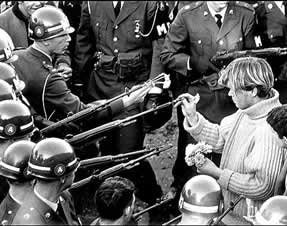
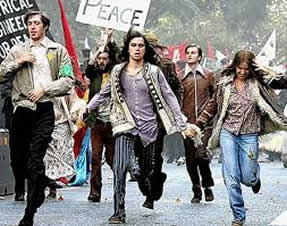
In response to the violence, Hoffman wrote in WIN magazine, “Plans are being made to mine the East River with daffodils. Dandelion chains are being wrapped around induction centers…. The cry of ‘Flower Power’ echoes through the land. We shall not wilt.”
On the following Sunday in May 1967, WIN activists declared the Armed Forces Day as “Flower Power Day” and held a rally in Central Park to counter the traditional parade. Turnout was low and, according to Hoffman, the rally was ineffective because guerilla theater needed to be more confrontational. In October 1967, Hoffman and Jerry Rubin helped organize the March on the Pentagon using Flower Power concepts to create a theatrical spectacle.
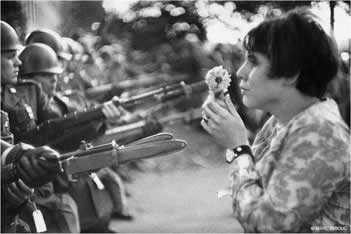 Photographs of flower-wielding protesters at the Pentagon March became seminal images of the 1960s anti-war protests.
Photographs of flower-wielding protesters at the Pentagon March became seminal images of the 1960s anti-war protests.
An image by French photojournalist Marc Riboud that was printed throughout the world was of seventeen-year-old high school student Jan Rose Kasmir clasping a daisy and gazing at bayonet-wielding soldiers.
Smithsonian Magazine later called it “a gauzy juxtaposition of armed force and flower child innocence”.
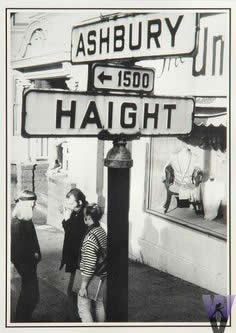 The iconic center of the Flower Power movement was the Haight Ashbury district in San Francisco, California.
The iconic center of the Flower Power movement was the Haight Ashbury district in San Francisco, California.
By the mid-1960s, the area, marked by the intersection of Haight and Ashbury Streets, had become a focal point for psychedelic rock music.
Musicians and bands like Jefferson Airplane, the Grateful Dead and Janis Joplin all lived a short distance from the famous intersection.
During the 1967 Summer of Love, thousands of hippies gathered there, popularized by hit songs such as “San Francisco (Be Sure to Wear Flowers in Your Hair)”.
A July 7, 1967, Time magazine cover story on “The Hippies: Philosophy of a Subculture,” and an August CBS News television report on “The Hippie Temptation” as well as other major media interest exposed the hippie subculture to national attention and popularized the Flower Power movement across the country and around the world.
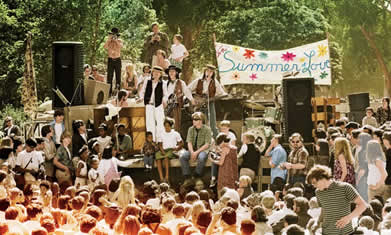
The avant-garde art of Milton Glaser, Heinz Edelmann, and Peter Max became synonymous with the flower power generation. Edelman’s illustration style was best known in his art designs for The Beatles 1968 animated film Yellow Submarine. Glaser, the founder of Push Pin Studios, also developed the loose psychedelic graphic design, seen for example in his seminal 1966 poster illustration of Bob Dylan with paisley hair.
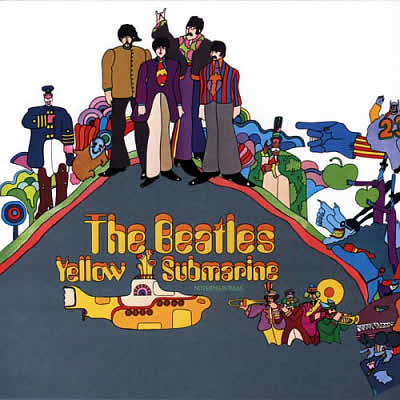
It was the posters by pop artist Peter Max, with their vivid fluid designs painted in Day-Glo colors, which became visual icons of flower power. Max’s cover story in Life magazine (September 1969) as well as appearances on The Tonight Show Starring Johnny Carson andThe Ed Sullivan Show, further established “flower power” style art into mainstream culture.
